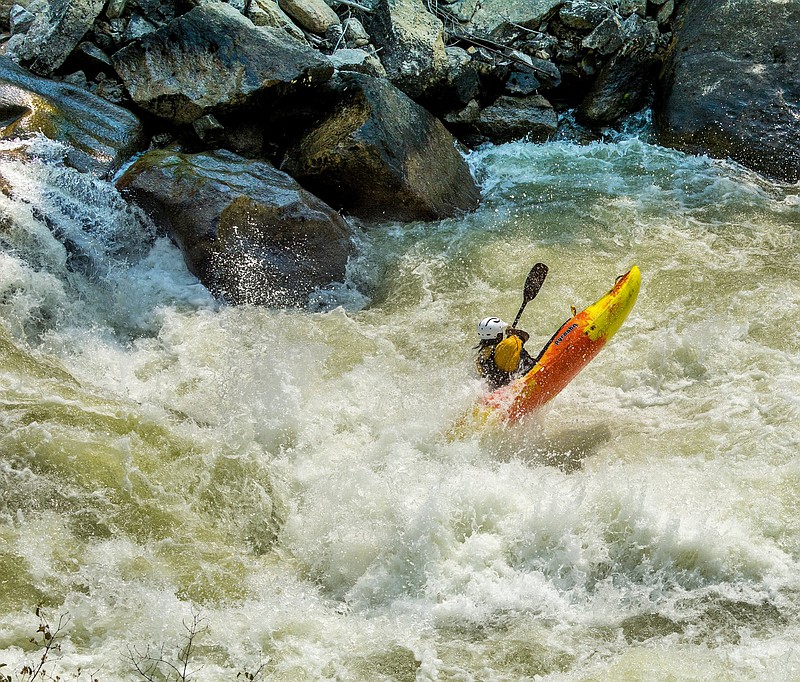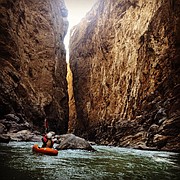The ebb and flow of life has often been compared to a river's ever-changing features, and no one understands this metaphor better than a creek boater.
I recently sat with a group of whitewater paddlers - Tyler Burns, Evan Alfano and Jesse Carter - and listened to them swap stories about their recent van trips south: Burns to Peru, Alfano and Carter to Mexico. They spoke of their adventures while simultaneously planning their next trip to flip burgers in Idaho, kayaking to work every day on the Payette River at the confluence of the North and South Fork. Their stories bounced around the dinner table, reflecting the same sort of dynamic flow of spirit, acceptance of change and happy simplicity of their lifestyles.
Paddling In Peru
Peru was never on Burns' radar until last summer. Originally, he'd been planning on heading south to Mexico for the winter, but felt a trip to Peru might pose a better challenge.
Peru is full of multi-day (4-7 days) paddling surrounded by what Burns calls "big-water boulder gardens: large labyrinths of car- or house-size rocks that are settled in some of the deepest canyons in the world." Prior to the trip, he'd only completed a couple of overnighters, and the thought of longer river journeys appealed to him. It also scared him. Running Class V rapids with a heavy boat full of food, camping and safety gear is uncomfortable for most creek boaters, who tend to paddle with nothing except the necessities for a quick trip. Peru is pretty untapped for creek boaters.
"We went into every run not knowing what to expect other than that someone had done it before, and somewhat of an idea of how many days it should take," says Burns. For him, these risks reflected a "true adventure," and his first experience with expedition style boating.
Beyond the draw of a new type of boating, Burns was also attracted to the unique landscape of the Andes, the second-largest mountain range in the world. Everything was bigger than anything he had experienced before (including the epicly long shuttles to the brutal portages).
"Having 20,000-plus-foot mountains looming overhead is a pretty surreal thing. On one river, the Puacartambo, we went from a high alpine desert all the way into the Amazon jungle. Such a variety of foliage for a day," Burns says.
He and some friends set up their home base out of Cusco, once the capital of the Inca Empire, and rented a barebones apartment still under construction for a month. Every river was at least a six-hour van ride from there, but it was the most centrally located spot to most of the rivers.
While their setup sounded ideal, a true adventure does not come without turbulence.
After their paddling adventure had begun, one night, after falling asleep in the heart of the Abysmo Canyon on the Rio Apurimac, Burns awoke to small raindrops coming through the mesh of his bivy. The sky was lighting up. The crew got up and tried to find a cave to sleep in, but they had to settle with squeezing together under a large boulder. Soon, a downpour overtook the canyon. Burns says he almost enjoyed it until he started to hear the sound of lightning crashing off the canyon walls and saw sparks fly. Rock and debris began to fly down into the river every few minutes, and it dawned on him that one of the boulders could come loose right above where they were camping. He also noticed that the river was rising with the crux of the run still below them. If the water came up enough, they would be stranded on the beach until the water level dropped.
"We were situated in the heart of one of the most intense and difficult runs in the country, surrounded by vertical walls that lead into one of the highest mountain ranges in the world - a sub-optimal place for hiking out," says Burns.
Sooner or later, the boys managed to fall asleep. They woke to a foggy haze. No rocks had come down to crush them in their sleep, and when Burns walked over to the river's edge, the water had risen only a couple centimeters.
The next day of paddling, he says, was the most mentally and physically exhausting day of his life. And one he will always cherish.
After paddling six days from the high mountains into the jungle, the crew had a takeout in a small village where it became evident to them that not many white men had ever visited before. They became a spectacle walking through the village, lugging their boats, in search of a place to sleep and transportation back to Cusco. They were on a dirtbag budget, says Burns. But those struggles were minor compared to the whitewater.
"Paddling through Peru taught me a lot. It taught me patience and eternal optimism. The water governs all," Burns says.
Boating affects everything in a boater's life - from friendships to jobs to where one lives.
"We have to move to live, work and play," says Burns, who has lived in Tennessee, North Carolina, Colorado, Washington, Oregon and Idaho, all in pursuit of whitewater. The best example of how his sport steers his life was his move to Idaho.
Burns had recently moved to the fabled Hood River in Oregon and gotten a job as a cook. He had just finished training at the restaurant when he went to his boss and begged for a few days off in order to travel to Idaho for the North Fork Championship, the baddest river race out there (sorry, Green Racers). Upon arriving in Idaho and seeing the whitewater, he knew immediately he had to move. The next morning, Burns drove back to Oregon, quit his job and struck right back to Idaho where, he says, he had the best summer of his life.
The water truly governs all. Kayaking has changed Burns' life into a journey of perpetual movement.
"I seriously want to live in a van down by the river," he says. "It comes with a certain stigma. It makes relationships tough." But Burns stays focused on the big picture. "I'm most definitely living my dream. How many people can honestly say that?"
Mexican Standoff
Alfano and Carter's expedition to Mexico was quite different than Burns' experience. They had paddled in Mexico previously. And, their crew included one van, five guys, 15 paddles and nine boats.
In Mexico, they stayed in a hostel in Tlapacoyan called Adventurec, a mere two hours from nearly everything they wanted to run. The trip got off to a simple start - with the exception of their first river run.
The day they crossed the border, the boys went to the Rio Valles in San Luis Potosi, where they set up camp as the sun was going down. They decided to do a quick run on the Micos section of the river. After paddling for a while, they came upon a downed tree in one of the major rapids, about the width of a car. Foliage was blocking the sunlight and they had to maneuver under it, ducking into the dark.
The crew started through, one by one.
"But then we looked back and our buddy Paddy was stuck against the log. It was pitch black - we didn't have our headlamps - but his boat was stuck up against the tree, so Paddy swam out and Evan and Pat ran back to get headlamps and get his gear. Everything was OK, but it was a crazy way to start the trip," says Carter.
He and Alfano say there (thankfully) weren't many more unnerving moments like that on their trip. Mostly, it was a month of paddling beautiful rivers. One high came toward the middle of their trip when they spent a week at the Rio de Oro (Gold River). The group paddled through a gorge, through rolling, volcanic hills, until they came out in the Gulf of Mexico. Then, they paddled up the coast and stayed at a hostel on the beach for a few days.
Still, danger is always present in the lives of boaters. Alfano recounts another unnerving moment during the trip. "One of the Ukrainians we were boating with in the Oro went off a seal launch and didn't catch the current the right way, so she got caught in an eddy at the foot of a fall. She couldn't swim out because the current was strong, and she couldn't hike or climb out because the walls were steep, basalt rock. It took us about an hour to get her out, hand-over-hand pulling her up out of the canyon after trying multiple rescue approaches. But she still had to finish," he says.
I've heard stories about boaters getting caught in sieves and drowning or breaking their backs and having to be lifted out of a river. Alfano admits that he is nervous every time he goes kayaking and before every drop. But, says Carter, "You get rattled, survive - and keep going. Then you're less nervous."
Having a routine can also help. Every morning, the crew in Mexico had a ritual to help them get their minds right. One part was to shoot off fireworks. "They're bigger and louder than Tennessee fireworks. So they set the tone for the day and shook our nerves up," Carter says.
As I listen to them tell their tales, the boys' voices become more and more excited - excited about their freedom to move and the flow of their lives.
"It's a trade-off," says Alfano. "No matter what your lifestyle is, you will have hardships. If you decide to have a house, a car, etc., then you will always be working that off. I want a life where I am free from those sorts of struggles."
These boys exude freedom.
"Because of kayaking and living the life I do, I now have friends all over the country, all over the world," says Burns, who is currently living out of a van - albeit not by the river - in the backyard of a man he met in Idaho. "I love the simplicity of the lifestyle. Constantly being in the outdoors, being active, living simply and being surrounded by good people culminates into a low-stress, happy life. I'm glad I've found my way into it."

